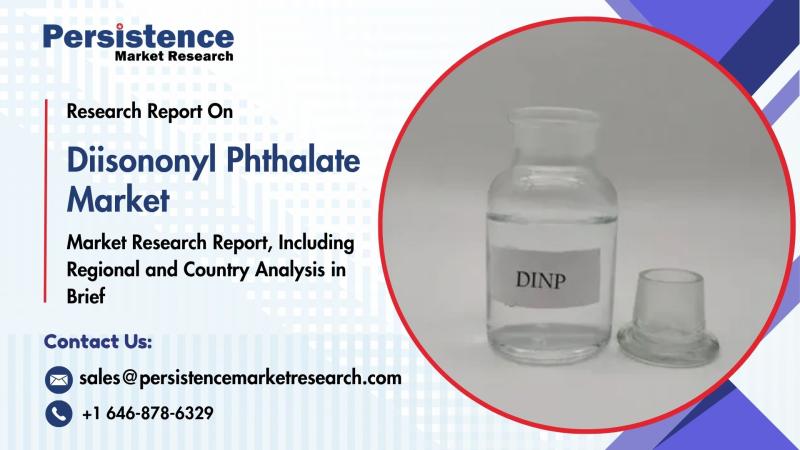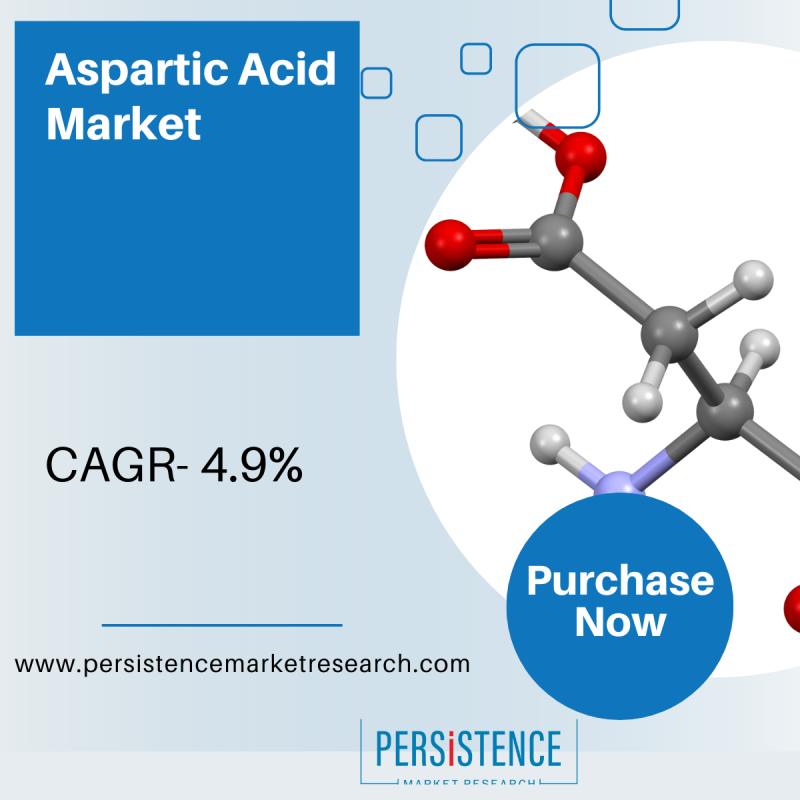Press release
Global Aspartic Acid Market Analysis and Forecast by 2023: Surging Demand from Chemical and Pharmaceutical Industries to Drive CAGR Growth 4.9%
Global Industry AnalysisAspartic acid is an alpha amino acid due to its carboxylate anion and aspartate named after aspartic acid. When aspartate and glutamate combine, the result is known as an acidic amino acid. There are two types of aspartic acid enantiomers on the market: D-aspartic acid, which is rare in nature, and L-aspartic acid, which is directly incorporated into proteins.
Aspartic acid is a non-essential amino acid that is found in many proteins and is involved in the synthesis of other amino acids, such as methionine and threonine. It is commonly used as a flavor enhancer, in the production of food and beverage products, and as a nutritional supplement. The global aspartic acid market is projected to reach $186.1 million by 2023, growing at a CAGR of 4.9% from 2015 to 2023.
Click on the link for the sample report: https://www.persistencemarketresearch.com/samples/4268
The global market has been expanding significantly owing to the expansion of its end-user industry. The aspartic acid market is witnessing a dramatic growth owing to increasing meat consumption. However, L-aspartic acid, a form of aspartic acid, has been subject to price pressure because the sweetener market, one of the product's main uses, is highly competitive. As a result, US producer Solutia Inc. stopped producing L-aspartic acid at its plant in Missouri in December 2003, citing global overcapacity as the main reason for its withdrawal from the market.
Major manufacturers have entered into several collaborations and agreements with other companies for the marketing of new products and gaining a larger share in the market. Large companies such as Royal DSM, which stand in the challenging L-aspartic acid market, are using their production advantages to maintain their leading positions in the industry.
As competitive pressure intensifies, the company is touting its reliable supply of raw materials and experience in all applications of its products to grow its business.
Click on the link to customize the report: https://www.persistencemarketresearch.com/request-customization/4268
In addition, the company has maintained a high price of raw materials by virtue of its raw material advantages. The company's status as a lagging integrated player makes it relatively competitive at a time when pricing pressure is affecting the market. DSM also produces maleic anhydride, which is used in the production of fumaric acid, a key raw material for L-aspartic acid.
Rising demand for meat is expected to be one of the major drivers for animal feed, thereby leading to the growth of the aspartic acid market. However, fluctuations in price and supply of raw materials are expected to slow down the growth of the market. Manufacturers are looking for more economical raw materials as prices of raw materials are soaring due to fluctuations in raw material supply as well as adverse weather conditions.
Promising applications such as production of biodegradable water-soluble specialty polymer polyaspartic acid (PAA) and polyaspartic acid derivatives for industrial applications are expected to provide new opportunities for market growth. Large companies such as Royal DSM are suppliers to Illinois-based Donlar Corporation, which has been using L-aspartic acid as a feedstock for its PAA production.
Ajinomoto Co. Inc., Anaspec, Inc., ChemPep Inc., Iris Biotech GmbH, PepTech Corporation, and Royal DSM are some of the major manufacturers of aspartic acid dominating the market.
This report covers a thorough analysis of:
• Market segment
• Market dynamics
• Market size
• Supply demand
• Current Trends/Issues/Challenges
• Competition and related companies
• Technology
• Value chain
Regional analysis includes:
• North America (USA, Canada)
• Latin America (Mexico, Brazil)
• Western Europe (Germany, Italy, France, UK, Spain)
• Eastern Europe (Poland, Russia)
• Asia Pacific (China, India, ASEAN, Australia and New Zealand)
• Japan
• Middle East and Africa (GCC countries, South Africa, North Africa)
Report highlights:
• Detailed overview of the top markets
• Changing market dynamics of the industry
• In-depth market segmentation
• Historical, current and projected market size in terms of volume and value
• Recent industry trends and developments
• competitive landscape
• Strategies of major players and products provided
• Potential and niche segments, areas showing promising growth
• A neutral view of market performance
• Essential information for market participants to maintain and strengthen their market footprint
Click on the link to book the report: https://www.persistencemarketresearch.com/checkout/4268
Related Reports -
Pulp and Paper Processing Chemicals Market: https://www.persistencemarketresearch.com/market-research/pulp-and-paper-processing-chemicals-market.asp
Dimer Fatty Acid Market: https://www.persistencemarketresearch.com/market-research/dimer-fatty-acid-market.asp
Methanol Market: https://www.persistencemarketresearch.com/market-research/methanol-market.asp
Contact us:
Persistence Market Research
Address - 305 Broadway, 7th Floor, New York City,
NY 10007 United States
U.S. Ph. - +1-646-568-7751
USA-Canada Toll-free - +1 800-961-0353
Sales - sales@persistencemarketresearch.com
About us:
The Chemicals and Materials division of Persistence Market Research offers distinct and pin-point analysis about chemicals and materials industry. Chemical coverage extends from commodity, bulk, specialty and petrochemicals to advanced materials, composites and nanotechnology in particular with special emphasis on 'green alternatives', recycling and renewable technology developments, supply-demand-trade assessment. Our research studies are widely referred by chemical manufacturers, research institutions, channel partners and government bodies for developing - 'The Way Forward'.
This release was published on openPR.
Permanent link to this press release:
Copy
Please set a link in the press area of your homepage to this press release on openPR. openPR disclaims liability for any content contained in this release.
You can edit or delete your press release Global Aspartic Acid Market Analysis and Forecast by 2023: Surging Demand from Chemical and Pharmaceutical Industries to Drive CAGR Growth 4.9% here
News-ID: 2946763 • Views: …
More Releases from Persistence Market Research

Smart Door Lock Market Anticipated to Hit USD 9.89 Billion by 2032
The global smart door lock market is experiencing transformative growth as consumer demand for security, convenience, and smart home integration intensifies. The market size is projected to increase from US$ 3,059.7 Mn in 2025 to US$ 9,890.6 Mn by 2032, registering a robust CAGR of 18.3% during the forecast period. Rising concerns about home and workplace security, combined with rapid technological innovations, are fueling the adoption of smart door locks.…

Diisononyl Phthalate Market to Reach US$4.6 Bn by 2031 Driven by Rising Demand i …
The global Diisononyl Phthalate (DINP) market is undergoing a steady expansion, shaped by evolving industrial applications, regulatory dynamics, and technological innovations in plasticizers. As a key phthalate plasticizer, DINP is predominantly used in the production of flexible polyvinyl chloride (PVC) products. Its superior durability, flexibility, and resistance to weathering make it indispensable across a wide range of industries, from construction and automotive to consumer goods.
According to the latest study by…

Propylene Carbonate Market to Reach US$468.2 Mn by 2031, Driven by Rising Demand …
The global propylene carbonate market is entering a promising growth phase, fueled by rising demand across multiple industries, particularly in electronics, automotive, and paints & coatings. Propylene carbonate, a highly versatile organic compound, is widely recognized for its exceptional solvent properties, biodegradability, and low toxicity, making it a preferred choice in green chemistry applications.
According to the latest study by Persistence Market Research, the market is expected to grow from US$275.5…

Flexible Electronics Market Anticipated to Hit USD 5,880.6 Million by 2030
The Global Flexible Electronics Market is forecasted to expand at a CAGR of 11.4%, increasing from a value of US$ 2,762.0 million in 2023 to US$ 5,880.6 million by 2030. Flexible electronics is transforming the conventional electronics industry by integrating lightweight, bendable, and conformable devices into everyday life. These technologies are being widely adopted across consumer electronics, healthcare, automotive, and wearable technology sectors, promising increased portability, efficiency, and user-friendly designs.
Elevate…
More Releases for Aspartic
Aspartic Acid Market Size Forecast Between 2023-2032
The global Aspartic Acid Market is poised for substantial growth over the next decade, driven by increasing demand from various industries including food and beverage, pharmaceuticals, and agriculture. As we move towards 2032, the market is expected to witness significant advancements in technology, product innovation, and regulatory approvals, leading to a robust expansion in market size. This press release provides a comprehensive analysis of the Aspartic Acid Market, including key…
Aspartic Acid Market Expecting Huge Demand in Upcoming Years
The "Aspartic Acid Market" intelligence report, just published by USD Analytics Market, covers a micro-level study of important market niches, product offers, and sales channels. to determine market size, potential, growth trends, and competitive environment, the Aspartic Acid Market provides dynamic views. Both primary and secondary sources of data were used to generate the research, which has both qualitative and quantitative depth. Several of the major figures the study featured…
Aspartic Acid Market Size, Share, Growth Forecast 2023-2032
Aspartic acid, a pivotal component in the realm of biochemical engineering, has witnessed a remarkable surge in demand owing to its diverse applications across various industries. From pharmaceuticals to food and beverage, the versatility of aspartic acid has positioned it as a cornerstone in modern manufacturing processes. As we delve into the dynamics of the aspartic acid market, it becomes evident that its trajectory is influenced by a multitude of…
Aspartic Acid Market - Positive Long-Term Growth Outlook 2024
A new research report by Transparency Market Research offers a comprehensive evaluation of the global Aspartic Acid Market. The study, titled “Aspartic Acid Market - Global Industry Analysis, Size, Share, Growth, Trends and Forecast 2016 - 2024”, is available for sale on the firm’s website.
Aspartic acid is a non essential amino acid commonly known as asparaginic acid. The human body is capable of producing aspartic acid without the intake of…
Aspartic Acid Market Will Continue to Grow by 2021
Aspartic acid is an alpha amino acid with its carboxylate anion and salts of aspartic acid known as aspartate. Aspartic acid, when combined with glutamic acid is referred as an acidic amino acid. Two forms of enantiomers of aspartic acid are available in the industry: L-aspartic acid, which is directly incorporated into proteins, and D-aspartic acid, which is limited in nature. Most chemical synthesis tend to produce both form of…
Aspartic Acid Market - Positive Long-Term Growth Outlook 2024
Aspartic acid is a non essential amino acid commonly known as asparaginic acid. The human body is capable of producing aspartic acid without the intake of any food containing aspartic acid. Aspartic acid primarily helps in the release and production of hormones and also, in the functioning of the nervous system. Aspartic acid is essential to assimilate, digest, and utilize calcium, potassium, and magnesium aspartate. Aspartic acid is found in…
